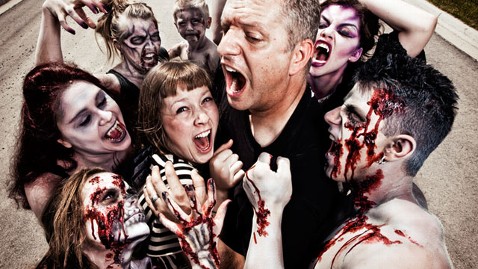New Report: Zombies Partly to Blame for Government Waste

Getty Images
ABC News Jonathan Karl and Gregory Simmons report:
When it comes to the dilemma of government spending, a zombie apocalypse hasn't been a part of the discussion - until now.
In his latest report on government waste, "Safety at Any Price," Sen. Tom Coburn, R-Okla., argued that Homeland Security funds allocated after 9/11 to shore up the U.S. anti-terrorism defense are being misused. He pointed to a five-day counter-terrorism summit that included a " zombie apocalypse" demonstration.
According to Coburn's report, the HALO 2012 Counterterrorism Summit was attended by law enforcement officials from around the country who were allowed to use DHS-awarded grant funds to pay the $1,000 entry fee.
Organizers of the conference at Paradise Point Resort & Spa outside San Diego said say the skit was solely to add levity to an otherwise serious meeting on protecting the homeland. Proponents within the federal government have touted the " zombie apocalypse" campaign as an attention-grabbing way to get people to focus on being prepared for real-world disasters.
Coburn on the other hand, said it is just one more example of an estimated $7 billion in questionable homeland spending every year.
"That is $7 billion that your kids and my kids are going to pay back is something that we got no increased security for," Coburn said. "I don't care if you use zombie apocalypse, what is the metric that said this was an effective use of the money."
Coburn's report is the result of a year-long probe by his office into one of the largest terror-prevention grant programs at the DHS - the Urban Area Security Initiative. While the program's original intention was to make U.S. cities less vulnerable to terrorist attacks, Coburn cites example after example of what he said are questionable uses of federal tax dollars.
There's the $30,000 underwater robot that was purchased by the city of Columbus, Ohio, for bridge and train overpass inspection as well as search and rescue; the $69,000 hovercraft for Indianapolis; and the $2,700 teleprompter purchased by officials in Ascension Parish, La., to meet "the national priority to expand regional collaboration."
No matter the price tag, the report questions whether federal funds intended to deter terrorism are being put to optimum use.
The sleepy town of Keene, N.H., for example, obtained a military grade BearCat armored vehicle early this year with DHS grant funds, citing the need to secure its annual pumpkin festival. Price tag: $285,933. The town has had only two murders in the past 15 years.
And while Fargo, N.D., also boasts one of the lowest crime rates in the country, it received more than $8 million in Homeland Security grants and used $256,643 of them to buy its own armored truck.
Small towns across America - like Keene, Fargo, Syracuse, Manchester and Clovis - are now prime targets for the manufacturer of the BearCat, Lenco, which now includes an eight-page guide on grant writing on its website.
The Department of Homeland Security declined an interview with ABC News, but wrote in a statement that it "fundamentally disagrees with the report's position on the value of homeland security grants" that "make our communities safer places to live."
But Coburn said there's too much waste. He says it's "all over the government, everywhere you look - waste, incompetence, and stupidity."
But then again, can you ever be too prepared for the zombie apocalypse?